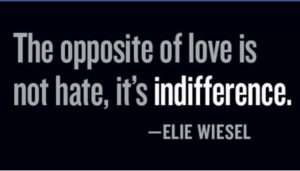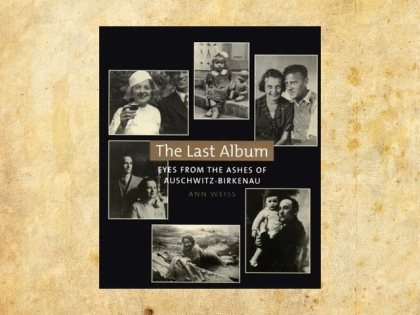Home

ABOUT ANN AND THE LAST ALBUM

In October of 1986, during a tour of Auschwitz, I unexpectedly came upon a locked archive whose contents were to become the inspiration for THE LAST ALBUM: Eyes from the Ashes of Auschwitz-Birkenau. There I discovered over 2000 personal photographs, confiscated from Jews deported in 1943. These were the photos they couldn’t leave behind. Millions of photos were brought by millions of people to Nazi slave labor and death camps, but there was a secret Nazi edict to destroy not only the people, but also to destroy the symbols of their memories, i.e. all their personal photos, all their letters and all their drawings. Historians have surmised that, out of all the transports, only the photos from this one transport miraculously survived. How? Why?
As James Young, in his introduction to The Last Album (p.18) has explained,
Ann Weiss’ collection of photographs shows us what was lost. Moreover we not only have a record of how the victims would have remembered their own lives, but we now have a visual record of that which constituted the fullness of life itself children playing, lovers strolling the quotidian moments that actually made up life itself.
This website is a companion to my book, traveling photo exhibition and video. Please understand that we are still in the process of organizing new aspects to the site, more historical background, educational components, and of course, adding more photos and the stories behind them. Explore the contents of this site. You can peruse the Media section for highlights and excerpts of television and radio interviews, and as always, I’m interested in your feedback. As I can, I will be adding more material to enhance your understanding, and as more and more of you write to me, I will be adding your suggestions for use, etc.
Currently, we are involved in a funding initiative to make it possible for all these 2000+ remarkable photos to be seen. If you’d like to help with this effort, do please contact me directly at PO Box 1136, Bryn Mawr, PA 19010-7136. Both your time, and your tax-deductible gift are deeply appreciated. You can also reach me by email or on the discussion section of the site, with your thoughts, questions, identifications, and entries for the site.
I have shared these photos and narratives about their owners in many venues–theatres, museums, universities, community centers and schools, settings both ecumenical and secular. These images were the very ones Hitler never wanted you to see. These photos and their stories are emblematic of how these people wanted to remember their lives. Now you and I share a taste (in Yiddish, a tahm) of what they wanted to remember. As Leon Wieseltier writes in his Foreword to my book, “We have been initiated by their deaths into their intimacies. We remember what they wished to remember, and in the memory of their memory, they live.”
Ann Weiss, Ph.D. Director
ann@thelastalbum.org
Biography
Ann Weiss is the daughter of two survivors from Poland. She has worked as a researcher, writer, documentary filmmaker, librarian and educator. Founder and director of Eyes from the Ashes Educational Foundation, Weiss is an interviewer and analyst for the Transcending Trauma Survival Project at the University of Pennsylvania, and has served on the Second Generation Advisory Committee of the United States Holocaust Memorial Museum in Washington, D.C. since its inception.
Ann has a Ph.D. from University of Pennsylvania in Education, Culture and Society, focusing on narratives, life studies and culture of Holocaust survivors. In addition, she holds graduate degrees from The Annenberg School for Communications, where she specialized in visual and political communication, and also from Drexel University where she specialized in research techniques, as well as library service to adults, young adults and children. Her BA is from University of Rochester, where she majored in English and got certified to teach–as virtually every other English major also did at the time! Though she never stayed in one classroom, Ann has taught classes in schools and universities all over the country — and beyond, as well. Her goal is clear, though not so simple–to open minds, and in the process, open hearts.
In her Annenberg research, she investigated the impact of Holocaust images on public and private school students. In 1994, she introduced new research “Imagining the Unimaginable: Archival Photos from Auschwitz” at a conference in Berlin, co-sponsored by Humbolt and Oxford Universities, titled “Remembering for the Future.” In 1989, she premiered her documentary film, Eyes from the Ashes, in Jerusalem.
“An old man rushed up to the podium when I finished my speech in Israel. He pointed to one of the photos, a beautiful image of a bride and a groom, and said “I danced at this wedding!” At that moment, though I had believed that bringing these photos to Jerusalem had completed my work, I realized that, in reality, it had only begun. From that day until this day, I still search for names and stories, and most of all, people, who might belong to the photographs. In fact, just recently, on the night of the book’s premiere in Philadelphia, a man stood up and recognized his teacher! The story continues, and continues.”
“Each time a discovery is made, I feel as if, in a sense, a life has been reclaimed. Although I know it is not like restoring the dead to the living, I do know that each identification is important. The Nazis wanted their victims to be dehumanized— dead and dehumanized. They took away their names, replacing them with numbers. They destroyed their personal photos so that we could not see their faces. Not only did the Nazis destroy their lives, but they even tried to destroy the memory of their lives. With these photos, they can be remembered as people, not bodies, and in this sense, they live.”